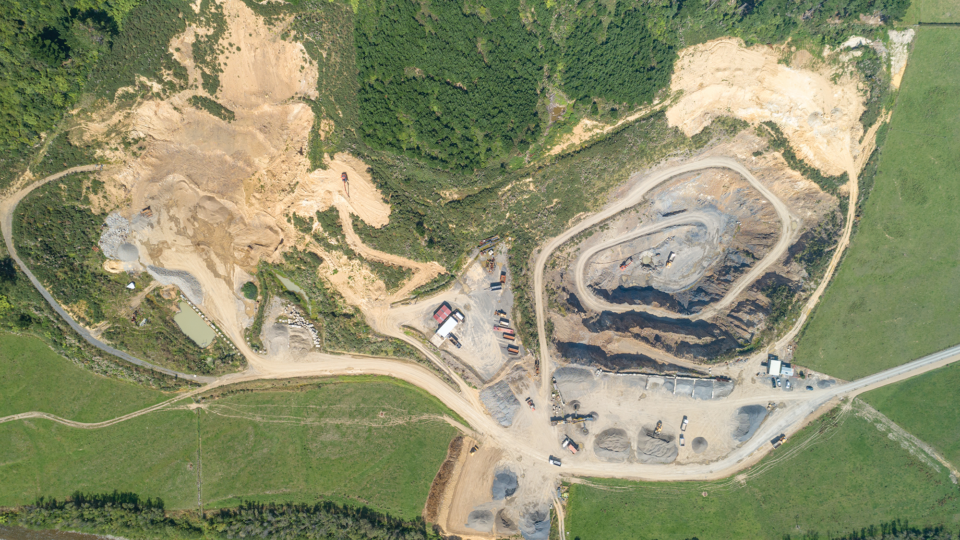The Ohau Quarry near Levin may be forced to close due to the intended extension of the Kapiti Expressway from Otaki to north of Levin, which on the proposed NZTA plan will see it cut right through the centre of the quarry. Richard Silcock spoke with former Ohau Quarry director Carl Gibson prior to his sudden death in January this year.
Located in the hinterland of the dairy farming and horticultural region of the Horowhenua, is the Ohau Quarry, some 10 kilometres south of Levin and off SH1.
The quarry was established 66 years ago to service the aggregate needs of local authorities, roading contractors and rural farmers and produces mainly AP20 through to AP100 aggregate from greywacke and gelite rock that is largely extracted through blasting.
The quarry changed ownership midway through 2021 and is now owned by Quality Demolition Services who operate in the Hutt Valley near Wellington. They purchased the extraction rights from the former Don Webb Quarries. The land itself belongs to a dairy farm and is leased on a royalty basis on a percentage of profit.
Carl Gibson was one of the co-company directors of the Ohau Quarry along with Shane Gray, who owns and operates Quality Demolition and another quarry near Masterton. When they purchased the rights to the quarry the proposed designation for the expressway was to be located some several kilometres to the west and on the other side of SHI, well away from the quarry, but this was subsequently changed.
They are now in the midst of negotiating a settlement figure with the Government through the NZTA for the loss incurred. At the end of last year, Carl Gibson told me it was early days, and NZTA hadn’t been “very forthcoming over the matter”, and the company was taking each day as it came.
As the quarry can’t get resource consent to take rock further to the east of the present quarry site, it means a total closure and the quarry’s customers will be forced to truck in aggregate from further afield, undoubtedly adding to the cost per tonne.
The quarry currently now has three full time staff, one of whom is Mike Johnson, the quarry manager who holds a quarry manager’s certificate.
The quarry covers an area of around 10-12 acres and has two pits, although when I visited the site late last year only one was operational. The main pit is 85 metres deep and a new face is blasted every three or four months with the rock extracted using several 30 tonne Komatsu excavators and a couple of Volvo and Komatsu loaders to fill articulated Volvo dumper trucks.
The material is fed into two new K4 and R5 Keestract crushers (both diesel-powered) that were bought new from Equip2 in Masterton and currently process around 250,000 – 300,000 tonnes. The quarry generally carries a surplus of around 10,000 tonne of processed aggregate at any one time to supply on demand.
Since the Kaikoura earthquake a challenge has been ground water seepage in the pit that needs to be pumped out 24/7 into several holding ponds on the surface.
Putting aside the expressway issue, it is estimated there is sufficient rock material for a further 30-40 years of extraction.
When I asked Carl what he saw as the big issues facing the quarry industry he told me they are: the increasing cost of diesel; the one qualification fits all; and the Government’s inability to face up to the need to have quarries close to cities and towns. The cost of diesel is driving up material costs and increasing construction and building costs.
The other issue, he said during my site visit, is the autonomous, one-size-fits-all, CoC and quarry manager certification that is very underground mining centred and not relevant to over-ground extraction.
Voicing what others have said in this magazine, Carl thought there needs to be a distinct separation made between the two extraction industries, and two separate qualifications. The current legislation was hurried and ill thought out, he thought, and is a reaction to the Pike River tragedy!
An advocate for maintaining quarries close to urban areas, Carl told me the Government needs to realise that quarries need to be reasonably close to users of aggregate if transport costs are to be minimised and, while the industry through the AQA is lobbying government over this issue, more and more quarries are being forced to close or move further out.
The Ohau Quarry supplies quality aggregate products for a number of uses; from road construction through to landscaping, construction and for drainage and this supply will be lost at the local level should the quarry close.
And, as Carl pointed out, construction work for the expressway extension, from Otaki to north of Levin is expected to start in two years-time and be completed by 2029 and will need plenty of aggregate.
It is with deep regret that since the original article was written based on an interview with Carl Gibson, Q&M learnt that he passed away suddenly on 20 January. The editorial team at the magazine pass on their sincere sympathy and condolences to the Gibson family, shareholders and the staff at Ohau Quarry.




